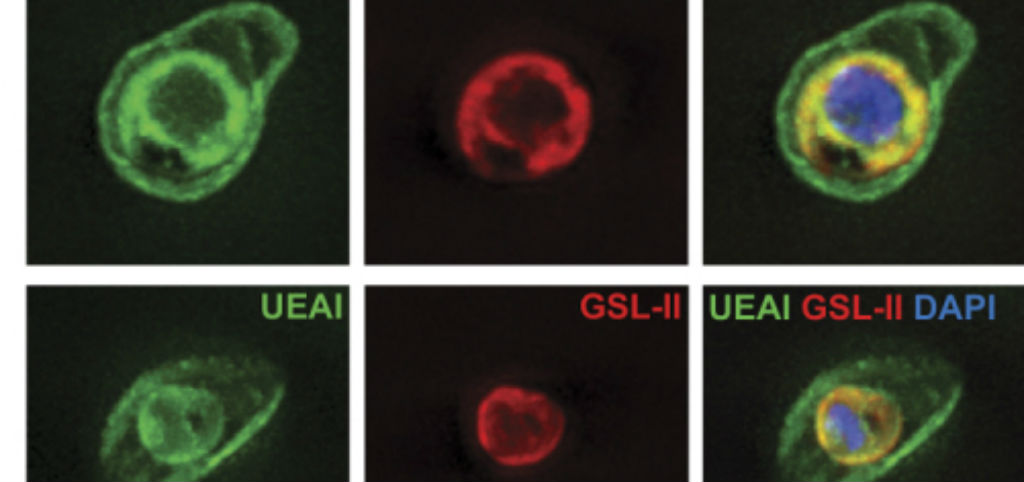PlasmoSugars
Exploration of the singularities of the sugar nucleotide metabolism and description of novel glycosylation pathways in the malaria parasite

- Duration
- 01/01/2014 - 30/06/2017
- Coordinator
- Luis Izquierdo
- Funded by
- MINECO (Spanish Ministry of Economy)
Glycosylation represents one of the most common and heterogeneous post-translational modifications of proteins, and complex glycoconjugates are involved in almost every biological process. Thus glycoconjugates play a major role in nearly every human disease.
Sugar nucleotides are the activated forms of sugars used as donor substrates in glycosylation reactions and our lab has precisely delineated the sugar nucleotide biosynthetic pathways in the malaria parasite. In contrast to the prevailing idea that the Plasmodium glycoconjugate structures are limited to glycosylphosphatidylinosytil (GPI) anchors, our works show that other sugar nucleotide and glycosylation pathways are active in the blood stages of the malaria parasite.
We aim to probe essential and/or unanticipated enzymatic steps in these metabolic routes that are unidentified in the P. falciparum genome. Among these unresolved issues are: i) the identity of the P. falciparum putative glucosaminephosphate N-acetyltransferase (GNA) that converts glucosamine-6-P (GlcN6P) to GlcNAc6P; ii) the source (and biological significance) of the UDP-galactose (UDP-Gal) pool detected in the blood-stages of the parasite. Furthermore, our previous studies have shown the presence of GDP-fucose (GDP-Fuc) pools through the asexual stages of P. falciparum life-cycle at levels comparable to other protozoan parasites. This, together with the incorporation of tritium labelled GDP-Fuc by cell extracts of the parasite, strongly suggests the presence of active fucosylation mechanisms in P. falciparum. Our works show that P. falciparum blood-stage cell lines with engineered alterations in the GDP-Fuc biosynthetic pathway are not labelled by the fucose-binding Ulex europaeus agglutinin I (UEA-I). Therefore, a fucosyl transferase could be involved in the synthesis of an uncharacterized UEA-I-glycotope on the surface of the parasite.
Detailed biochemical and genetic studies of these essential but much neglected biosynthetic pathways may improve our understanding of the parasite’s biology and provide urgently needed targets for chemotherapeutic intervention.
Total funding:
139,150 €
Our Team
PI
-
Luis Izquierdo Lazaro
ISGlobal team
-
Miriam Ramirez Moreno
Other projects
R21 AI151459-01A1
Longitudinal Antibody Profiles Correlated with Protection from Malaria in Malawi
BASEMALVAC
Baseline host and environmental factors that impact pre-erythrocytic malaria vaccine (hypo)responsiveness in endemic regions
GlycoTargets
New antimalarial therapies targeting the glycosylation pathways of ‘Plasmodium falciparum’
CLIMSOCTRYPBOL
Insight on climate and social participatory research for integral management of vectorborne zoonosis caused by Trypanosoma cruzi and Leishmania spp. in the Bolivian Gran Chaco.
VaMonoS
Unravelling the heterogoneity and function of monocytes in vaccination and immunity to malaria
VivaxEVTalk
Extracellular Vesicles as Intercellular Communicators and Biomarkers of Cryptic Erythrocytic Infections in Plasmodium vivax malaria
RESPONSE
Mechanisms of the transcriptional responses to changes in the environment in the malaria parasite Plasmodium falciparum
MalTransc
Transcriptional regulation of adaptation and developmental decisions in malaria parasites: from epigenetic variation to directed transcriptional responses




